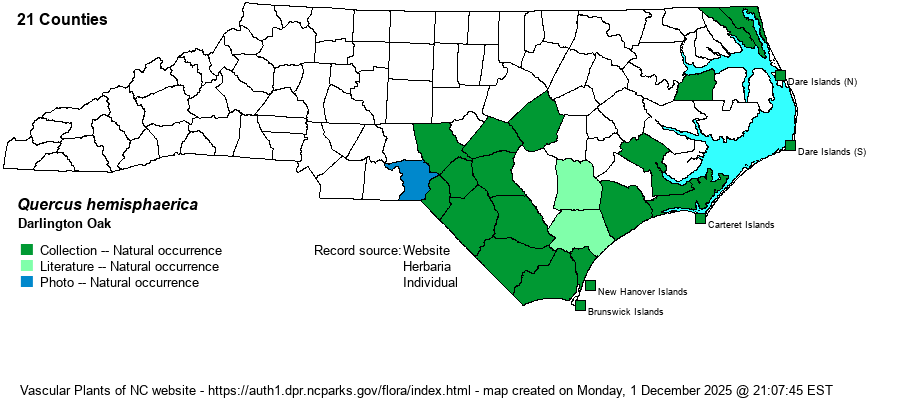| Author | Bartram ex Willdenow | |
| Distribution | Throughout much of the lower Coastal Plain and barrier islands, plus the southwestern portions, including the Sandhills region; certainly absent from the northwestern portion of the province. Does not range into the adjacent Piedmont.
This is a Southern species, essentially of the Coastal Plains, ranging north to southeastern VA, and south to southern FL and eastern TX.
| |
| Abundance | Within its somewhat limited Coastal Plain range, it is fairly common to common, and particularly numerous in coastal counties, where it grows in most maritime forests. Can be somewhat local farther inland (except in the Sandhills), where drier or sandier habitat is limited. Seems to do well in somewhat fire-suppressed sandhill habitats. | |
| Habitat | This is an upland species of sandy soil. It is found widely in maritime forests, as well as on low sandy ridges, sand flats, and in various Sandhill habitats (but usually not in deep sands), more so where fire has been suppressed for a few decades. Deep sands are usually occupied by other oaks such as Turkey (Q. laevis), Sand Post (Q. margarettae), Bluejack (Q. incana), and Sand Live (Q. geminata). |
| Phenology | Flowers in March and April, and fruits from September to November (of the second year). | |
| Identification | This species was lumped into Laurel Oak (Q. laurifolia) for so much of the last century that many biologists probably would not recognize or pay attention to this often common tree, simply calling it “Laurel Oak”. However, this is a medium to large semi- to nearly evergreen tree that grows to 60-75 feet tall, on average. It differs from the closely related Laurel Oak in that Darlington Oak has narrowly elliptic leaves, with no or just one or two tiny lobes or teeth near the tip (but can be quite “lobey” on saplings); has an acute leaf tip (though a tiny bristle at the tip); and grows in uplands on sandy or dry soil. Laurel Oak leaves are wider and typically slightly rhombic to diamond-shaped (or at least more ovate with less parallel sides than on Darlington Oak); has a rounded or blunt leaf tip; and grows essentially only in bottomlands and swamps. For additional separation characters, see Weakley (2018). The Willow Oak (Q. phellos) can be similar as well. However, that species averages narrower leaves (usually 5-8 times as long as wide), never shows lobing, has small tufts of hairs in axils of veins below (in mature leaves), and is deciduous, with leaves dropping in fall. Willow Oak normally grows in bottomlands, but it can grow in upland flats (especially on circumneutral soil), though it is infrequent in sandy soil. | |
| Taxonomic Comments | For most of the last century, it was unfortunately not recognized as different from, or was intentionally included within, Q. laurifolia. RAB (1968) did not even list it as a variety, much less as a good species. Most recent references do consider it as a good species.
| |
| Other Common Name(s) | Sand Laurel Oak is also a commonly used name. This name, however, then becomes confusing with Laurel Oak, which should then be called as Swamp Laurel Oak (as has been used by some). As Darlington Oak is often used, as well, this name causes no confusion whatsoever. Sometimes just “Laurel Oak” is used for this species, a completely confusing name. | |
| State Rank | S4? [S4] | |
| Global Rank | G5 | |
| State Status | | |
| US Status | | |
| USACE-agcp | FACU link |
| USACE-emp | FACU link |

